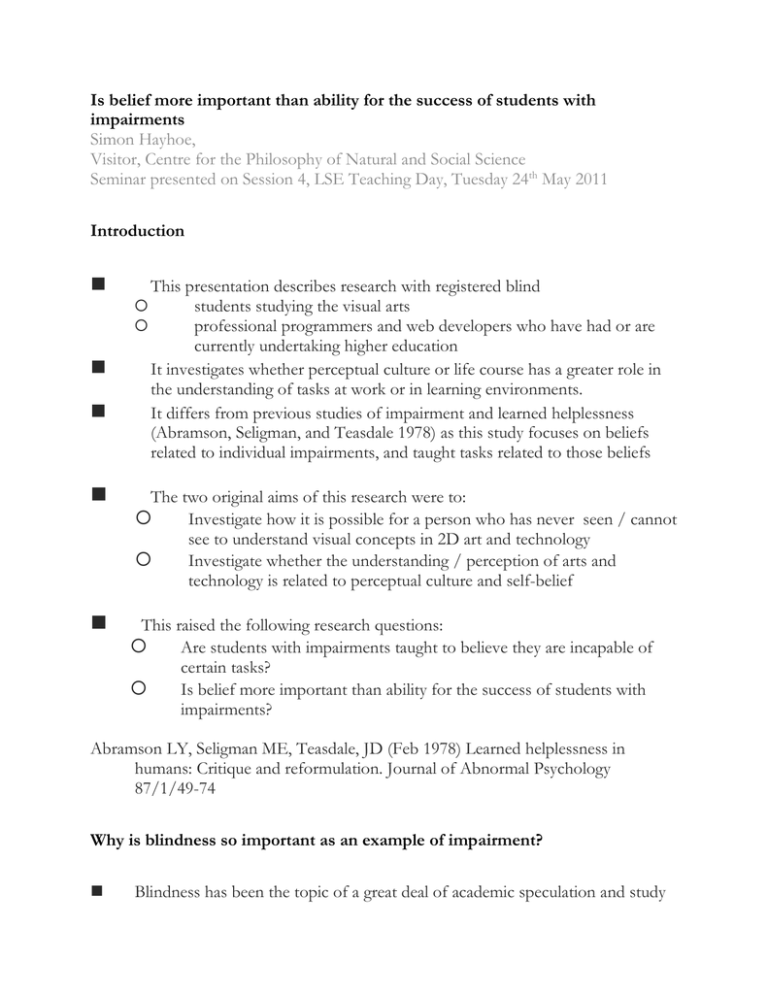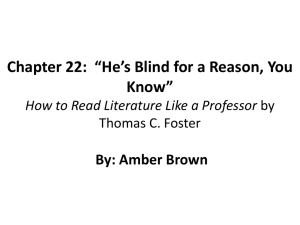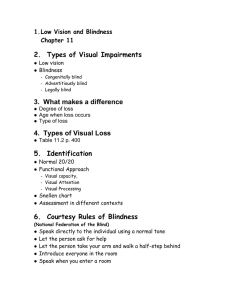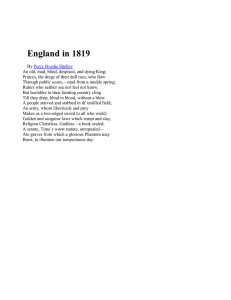Is belief more important than ability for the success of... impairments Simon Hayhoe,
advertisement

Is belief more important than ability for the success of students with impairments Simon Hayhoe, Visitor, Centre for the Philosophy of Natural and Social Science Seminar presented on Session 4, LSE Teaching Day, Tuesday 24th May 2011 Introduction This presentation describes research with registered blind students studying the visual arts professional programmers and web developers who have had or are currently undertaking higher education It investigates whether perceptual culture or life course has a greater role in the understanding of tasks at work or in learning environments. It differs from previous studies of impairment and learned helplessness (Abramson, Seligman, and Teasdale 1978) as this study focuses on beliefs related to individual impairments, and taught tasks related to those beliefs The two original aims of this research were to: Investigate how it is possible for a person who has never seen / cannot see to understand visual concepts in 2D art and technology Investigate whether the understanding / perception of arts and technology is related to perceptual culture and self-belief This raised the following research questions: Are students with impairments taught to believe they are incapable of certain tasks? Is belief more important than ability for the success of students with impairments? Abramson LY, Seligman ME, Teasdale, JD (Feb 1978) Learned helplessness in humans: Critique and reformulation. Journal of Abnormal Psychology 87/1/49-74 Why is blindness so important as an example of impairment? Blindness has been the topic of a great deal of academic speculation and study for millennia, with blindness debated at the foundation of the Enlightenment The asylum and education movement of blind and visually impaired people is one of the original forms of institutionalised special education Blindness is also the topic of the greatest number of moral and intellectual myths that can be tested Blind people are a clearly defined impaired population, with a clearly defined culture of media and technology The experiences of blind and visually impaired people are so distinct they could teach us something about self esteem / self confidence in general Hayhoe S (2008) God Money and Politics: English attitudes to blindness and touch, from Enlightenment to integration. Charlotte, North Carolina: Information Age Publishing Classifications of blindness and memory studied Total Blindness (TB) no light perception Minimal Light Perception (MLP) some light perception, but little enough to be usable Distorted Vision (DV) light perception, but highly distorted and registered blind, e.g. achromatism, photophobia, tunnel vision, no central vision No Visual Memory (NVM): Blind from birth / Very early blind, from infancy, 0-4 years Assimilated Blindness (AB): Blind from mid to late childhood, 4-18 years, educated in schools for blind, primarily non-visual Visual Memory (VM): Blind in adulthood, 18+ years Research structure The research structure was an epistemological approach to researching impairment. This included blindness: Studied through time – history of belief Studied as an observation of cultures and societies, and the influences on them (from the Enlightenment to 1981 – the first legal integration) Across time – behaviour resulting from these beliefs Studied as an observation of students (before & after 1981 Education Act). View points on impairments and ability: Psychological aspects of blindness Viewpoint: Geza Revesz, on perceptualism Study of blind artists in different eras One early blind student, Kleinhans, was taught from a young age by Klein Noted that all but one case study he found was later blind – blinded in adulthood All artists were sculptors Doubted blind people had a sense of aesthetics: “[From] what sources could a blind person, who has never seen the world with all its wealth of forms and colour, derive those manifold experiences?... [No] one born blind is able to become aware of the diversity of nature and to apprehend all the rich and various appearances of objects.” Revesz G (1950) Psychology and Art of the Blind. London: Longmans, Green & Co. Viewpoint: Steve Alexander, on perceptualism “Blind programmers could compete quite nicely in the IT workplace when the mainframe was king. But today, as graphically oriented Windows tool kits displace the text-based mainframe development, blind programmers are facing an uncertain future.” Steve Alexander, Blind Programmers Face an Uncertain Future, ComputerWorld, November 6th 1998 Viewpoint: Lev Vygotsky, on learnt beliefs “Every physical defect (sic.), be it blindness or deafness, alters the child’s attitude towards the universe and, primarily towards its fellow beings. Let us take, for instance, the geometrical place of a human being in the social sphere, his part and his fate as partaker of life and all functions of social existence, and we shall all come to the conclusion that everything is to be entirely altered on the case of the human being with any defect. Any physical defect provokes a social sprain, with unavoidable consequences. It goes without saying that blindness and deafness are biological facts and not at all of a social nature, but the [person] has to deal not so much with the facts as with the social consequences of these facts. When we have a blind child as an object of education before us, we are compelled to deal not so much with the blindness itself, as with the conflicts which arise therefrom within the child when it enters life…” Vygotsky LS (Van der Veer R & Valsiner J Eds.) (1994) The Vygotsky reader. Oxford: Blackwells The study of blindness (TB & NVM) and visual art culture: 1993-1995 Findings of case study findings – 1993-1995 All students were all totally blind and were either congenitally or early blind. Worked freely and with confidence on non-visual art tasks, but actively avoided any form of learning involving visual arts or worked only under very close supervision in creative art tasks Often only created ambiguous pieces in creative art tasks and /or appeared to create art pieces that would satisfy their tutors and repeated their interpretation Clear self confidence was established before the class in certain areas of learning Unlike learned helplessness, they had the confidence and ability to avoid tasks say they wanted to Follow on study of blindness (DV & AB) and visual art culture: 1999 – 2004 Case study 1: Emile, RNIB New College, 1999-2001 Early blind, in late teens, attended mainstream school and then New College as an early teen Had poor experiences of art education in mainstream Worked freely on art tasks he had learnt at New College, but actively avoided any tasks he learnt in mainstream Course was advanced and involved self motivated learning Negotiated his set tasks so that he actively avoided tasks he learnt earlier, and concentrated solely on tasks he felt he could do Differentiated self confidence in tasks with the same teacher and topic Clear that self confidence or lack thereof was established before the class Case study 2: Anna, RNIB New College, 1999-2001 Early blind, in late teens, attended mainstream school and then New College as an early teen Had very good experiences of art education in mainstream and generally outside of school – always drew Worked freely on art tasks she had learnt, and even took risks experimenting with tasks she had no experience of Course was advanced and involved self motivated learning Negotiated her set tasks so that she actively experimented with new methods and topics; in the end she took too many risks in some instances Self confidence in all tasks, and actively enjoyed risks Clear that self confidence was established before the class Comparison of styles of art: UK & US specialist teachers’ interviews Specialist teachers had taught students who had been excluded from their arts curricula, even-though they were physically included in the classroom Students who had these bad experiences were far less likely to attempt these activities later in their education There were cases of students who had been over praised, who had unrealistically high expectations of their ability – these expectations had been destroyed later when they re-entered mainstream Studies of professional programmers and web Developers: 2007-Present Summaries of selected programmers’ profiles Early Blind (Pre-1981) Case Study 1 Early Blind (Post 1981) Late Blind Case Study 2 Case Study 3 Case Study 4 Case Study 5 Age 45 57 50 33 26 Gender Male Male Male Female Male Category of Blindness & Memory TB & NVM TB & AB DV & VM TB & VM MLP & AB School Education School for the Blind School for the Blind Mainstream Schools Mainstream Schools Mainstream School Highest Educational Level Higher Education Higher Education Higher Education Postgraduate Higher Education Work Position Programming Website Developer Software Development Director Software Engineer Years Programming 28 36 36 Approx 20+ Years 9 Programming Language(s) Non-Visual (Cobol, C, Pascal, Fortran & Basic) Non-Visual (Assembly Language, HTML script) Mixed (Perl, HTML, SQL, PHP) Mixed (E.g. HTML, PHP, Java, XML, CSS) Mixed (E.g. MMC, C++, Java, Visual Basic, XML) Hayhoe S (Forthcoming) Non-Visual Programming, Perceptual Culture and Mulsemedia: Case studies of five blind computer programmers, In Multiple Sensorial Media Advances and Applications: New Developments in MulSeMedia (Ghinea G et. al. Eds). Hershey, Pennsylvania: IGI Global Case study 2 Completely blind, 57 year old British man. Residual vision until 14 years old. He attended schools for the blind and then university Considers himself to be of a blind culture, through language, technology applications He began learning to program at university in 1972. His early programs were written in Assembly Language “My first computer program was written at university 1972. The experience was quite interesting and had all the usual frustrations of surmounting the operating system before getting down to the logic (or otherwise) of the program. I used a Teletype and had sighted people reading for me” Used Teletype and Braille readers and writers, keyboard and audio interfaces to work through code and as an interface for everyday use. Now uses JAWS [a text reading program read through keystrokes]. “I currently use JAWS with Braille and speech. I have used Teletype / Optacon, I briefly used the Clarke and Smith Braille Link, which I rejected. The TSI VersaBraille, then IB80 Braille display.“ First accessed the web and email over twelve years ago using JAWs and Braille applications “I was connected to the Internet whilst working for Marconi in 1996, though I didn’t actively access the Web until 2000, when I established my own computer at home” Writes webpages with raw code. Will not work with visual languages “I was one of few who insisted on sticking to Assembly languages before giving up programming in the early 1990’s” “Yes, I write web pages, in basic HTML. As I’ve already said, I’m an information provider, not a web techie. I don’t do Java and visualise the information I’m presenting. The structure of the information informs the structure of the page. Nothing else makes sense to me” Particularly relies on structure and disciplined methods when scripting webpages “I don’t impose style or other limitations, leaving users to present our information in a way that best suits them. By providing concise, structured text, we achieve a high level of accessibility and usability for the vast majority of readers” Case study 4 Late completely blind, 33 year old British woman. She attended mainstream schools, higher education and is now a part-time postgraduate studying computer science. She became blind at 26 years old Still considers herself not culturally blind, either through language or her use of technology. Does not know many other blind people. She does not use Braille. Learnt programming using her father’s computer before the age of 10, using a text (command) based system. She began by copying programmes from magazines In earliest programming experiences she used text only, then used standard GUI systems. She cannot imagine the XP interface, which was released after she became blind. She accesses this system using JAWs “I rely entirely on the keyboard to interact with the screen reader and/or OS. For the most part it is an approach I’m capable of and comfortable with. There are inevitable frustrations, but these are born from other people’s inability to develop software that will support my goals, rather than my inability to do so with the right tools and skills” Late completely blind, 33 year old British woman. She attended mainstream schools, higher education and is now a part-time postgraduate studying computer science. She became blind at 26 years old Still considers herself not culturally blind, either through language or her use of technology. Does not know many other blind people. She does not use Braille. Learnt programming using her father’s computer before the age of 10, using a text (command) based system. She began by copying programmes from magazines In earliest programming experiences she used text only, then used standard GUI systems. She cannot imagine the XP interface, which was released after she became blind. She accesses this system using JAWs “I rely entirely on the keyboard to interact with the screen reader and/or OS. For the most part it is an approach I’m capable of and comfortable with. There are inevitable frustrations, but these are born from other people’s inability to develop software that will support my goals, rather than my inability to do so with the right tools and skills” Case study 5 He mainly uses screen readers to translate GUIs, including: “buttons, menus, menu bars, tool bars, scroll bars, icons, balloons, tool tips, edit controls, list and combo boxes to name a few” “screen readers I use have the ability to simulate mouse movement and control from keyboard; and this is normally the last resort to try to access inaccessible applications” Uses code indentation and code layout techniques whilst programming for clarity “I can tell you that I use code indentation and code layout techniques and have never had a problem getting any of my interfaces I’ve put together past our MMI people. (Well no more than any of the people I work with)” Accesses the web using a screen reader “As everything now uses a GUI of some kind it is impossible to use a computer without encountering the complexity of the GUI” He mainly uses screen readers to translate GUIs, including: “buttons, menus, menu bars, tool bars, scroll bars, icons, balloons, tool tips, edit controls, list and combo boxes to name a few” “screen readers I use have the ability to simulate mouse movement and control from keyboard; and this is normally the last resort to try to access inaccessible applications” Uses code indentation and code layout techniques whilst programming for clarity “I can tell you that I use code indentation and code layout techniques and have never had a problem getting any of my interfaces I’ve put together past our MMI people. (Well no more than any of the people I work with)” Accesses the web using a screen reader “As everything now uses a GUI of some kind it is impossible to use a computer without encountering the complexity of the GUI” Conclusion Are students with impairments taught to believe they are incapable of certain tasks? There is evidence that students in extreme cases can be taught that they are incapable of tasks within their learning either: By being excluded from certain tasks or techniques whilst being included in classes or other educational settings Having negative expectations or experiences being put upon them by their teachers Is belief more important than ability for the success of students with impairments? In the case studies discussed here, early positive and negative / nonexistent educational experiences affected later behaviour more than level of blindness. Behaviour and self confidence was also differentiated within the individual; i.e. people actively worked towards tasks that posed no threat to their self confidence, and they had previously had good experiences of and actively avoided tasks in their work / learning / assessment that they had been excluded from when younger, even when it meant that their livelihood or assessment grade would be affected Unlike learned helplessness, learnt inability was related to individual tasks and could be masked by success



